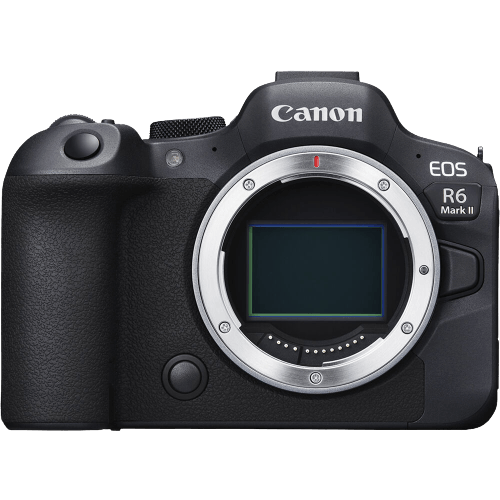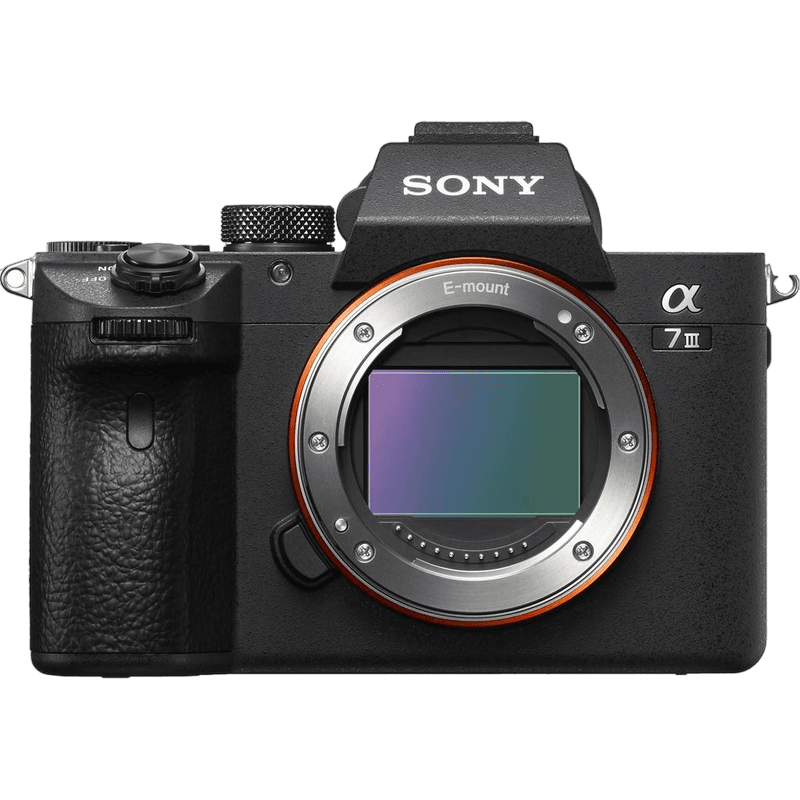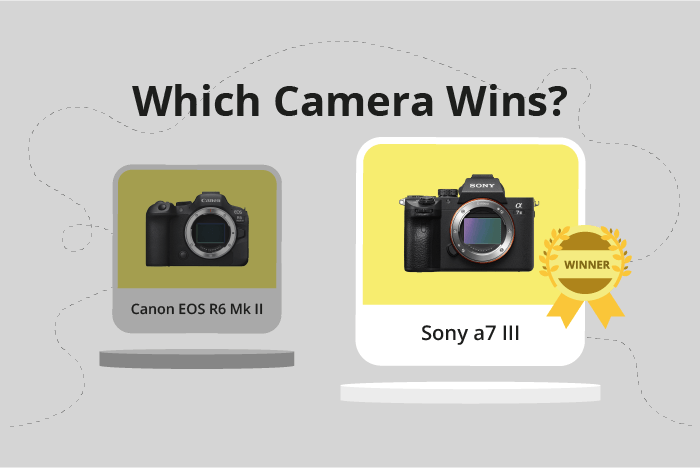Canon EOS R6 Mark II vs Sony a7 III Comparison
Canon EOS R6 Mark II

Sony a7 III

The Sony a7 III takes the lead with a score of 81, while the Canon EOS R6 Mark II trails closely behind with 78/100. Both cameras are mirrorless and share similarities in size and weight, with the Canon being slightly lighter at 588g and smaller at 138.4 x 98.4 x 88.4mm.
The Canon EOS R6 Mark II, released in 2022, offers a more recent launch. Despite its lower score, the camera’s lighter weight and smaller size provide advantages for photographers who value portability.
Taking these factors into account, the Sony a7 III emerges as the winner in this comparison, offering a higher score and better value. However, the Canon EOS R6 Mark II remains a strong contender for those prioritizing compactness and the latest technology.
Canon EOS R6 Mark II vs Sony a7 III Overview and Optics
The Canon EOS R6 Mark II wins the optics comparison with a score of 83/100, while the Sony a7 III scores 81/100. Both cameras have similar specifications, such as 24 and 24.2 megapixels, CMOS sensors, full-frame sensor sizes, and image stabilization. They also have different lens mounts, with the Canon using an RF mount and the Sony using an FE mount.
The Canon EOS R6 Mark II outperforms the Sony a7 III in certain areas. Its shooting speed of 40 is significantly faster than the Sony’s 10, allowing for more efficient and responsive shooting. The Canon’s Digic X processor also provides faster processing and better image quality compared to the Sony’s Bionz X processor.
On the other hand, the Sony a7 III has a higher DXOMARK score for its sensor at 96, compared to the Canon’s score of 91. This means that the Sony’s sensor performs better in terms of dynamic range, color depth, and low-light performance. However, this advantage may not be significant enough to overcome the other benefits provided by the Canon EOS R6 Mark II.
In the optics comparison, the Canon EOS R6 Mark II is the better camera due to its faster shooting speed and more advanced processor. The Sony a7 III does have a slightly better sensor, but this advantage is not enough to make it the winner in this comparison. Both cameras offer excellent image quality and features, but the Canon EOS R6 Mark II’s superior performance makes it the preferred choice for photographers seeking the best optics.
Canon EOS R6 Mark II vs Sony a7 III Video Performance
The Canon EOS R6 Mark II outperforms the Sony a7 III in video capabilities with a score of 83 compared to the Sony’s 70. Both cameras share common specifications, such as 4K max video resolution and max video dimensions of 3840 x 2160. However, the Canon EOS R6 Mark II surpasses the Sony a7 III in certain aspects, making it the winner in this comparison.
One significant advantage of the Canon EOS R6 Mark II is its max video frame rate of 60fps, while the Sony a7 III only offers a max video frame rate of 30fps. This higher frame rate allows for smoother and more detailed video capture, particularly in fast-moving scenes or when shooting slow-motion footage.
Despite its lower video score, the Sony a7 III still delivers high-quality 4K video resolution and impressive video dimensions. However, its lower frame rate and lack of built-in time-lapse functionality give the Canon EOS R6 Mark II a clear advantage in terms of video capabilities.
Canon EOS R6 Mark II vs Sony a7 III Features and Benefits
The Sony a7 III outperforms the Canon EOS R6 Mark II in features with a score of 81/100 compared to the Canon’s 72/100. Both cameras share several specifications, including a 3-inch screen size, touchscreen functionality, flip screen, WIFI, and Bluetooth connectivity. However, the Sony a7 III excels in certain areas, while the Canon EOS R6 Mark II has its own advantages.
The Sony a7 III boasts a higher screen resolution of 921,600 dots, which provides clearer and sharper image previews compared to the Canon’s 1,620,000 dots. Additionally, the Sony a7 III includes GPS functionality, which is absent in the Canon EOS R6 Mark II. This feature allows users to geotag their photos, making it easier to organize, locate, and share images based on their location.
On the other hand, the Canon EOS R6 Mark II still has its merits. Although it has a lower overall feature score, it does not necessarily mean it is an inferior camera. Users may find the Canon’s interface and controls more suitable for their needs and preferences. Moreover, the Canon brand has a strong reputation for producing high-quality cameras and lenses, which may appeal to loyal Canon users.
When comparing the Canon EOS R6 Mark II and the Sony a7 III, the latter emerges as the winner in terms of features. The higher screen resolution and GPS functionality contribute to its superior score. However, the Canon EOS R6 Mark II remains a viable option for users who prioritize brand loyalty and user experience. Ultimately, the choice between these two cameras depends on individual preferences and requirements.
Canon EOS R6 Mark II vs Sony a7 III Storage and Battery
The Canon EOS R6 Mark II and Sony a7 III both score 68/100 in storage and battery, showing no difference in this aspect. Each camera features two memory card slots, with both accepting SD, SDHC, and SDXC cards. However, the Sony a7 III also supports Memory Stick Duo, Pro Duo, and Pro-HG Duo cards, offering more versatility in storage options.
The Canon EOS R6 Mark II uses an LP-E6NH battery, providing 360 shots per charge and USB charging capabilities. In contrast, the Sony a7 III is equipped with an NP-FZ100 battery, which lasts for 750 shots, giving it a significant advantage in battery life. However, the Sony a7 III does not support USB charging.
Despite equal scores, the Sony a7 III excels with longer battery life and additional memory card compatibility, while the Canon EOS R6 Mark II offers the convenience of USB charging.
Canon EOS R6 Mark II vs Sony a7 III – Our Verdict
Are you still undecided about which camera is right for you? Have a look at these popular comparisons that feature the Canon EOS R6 Mark II or the Sony a7 III:

